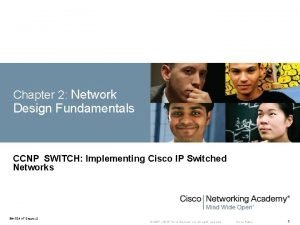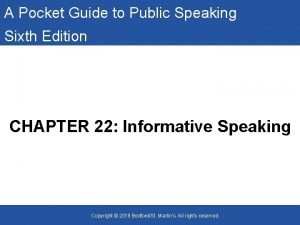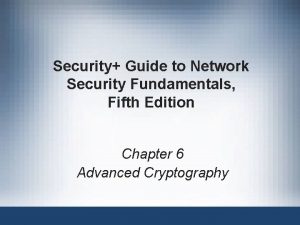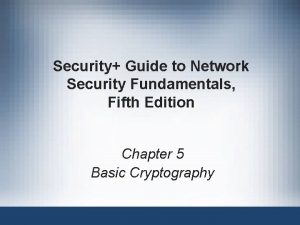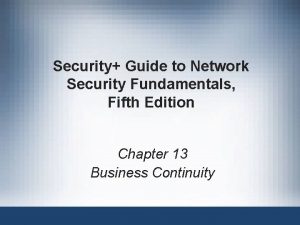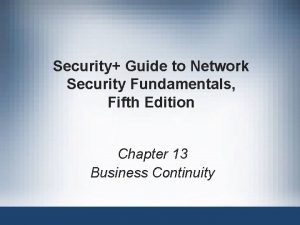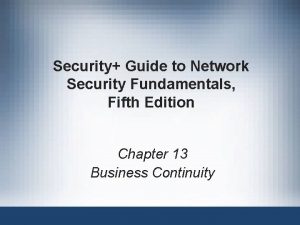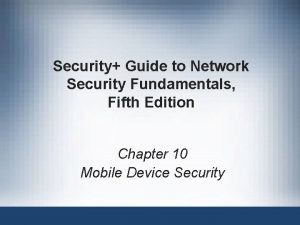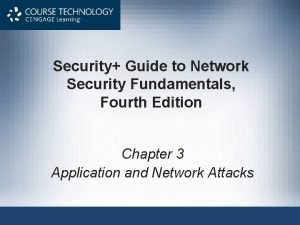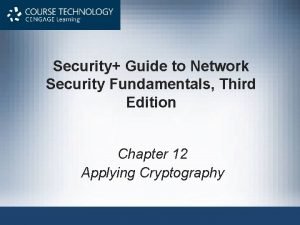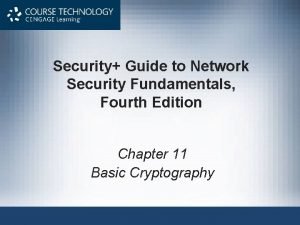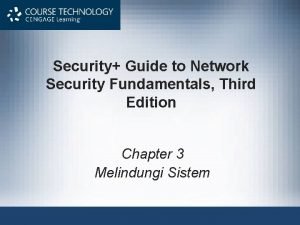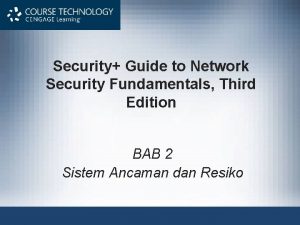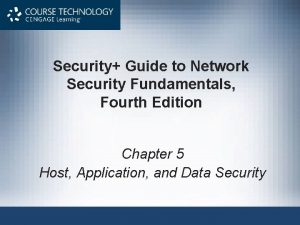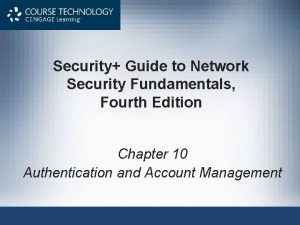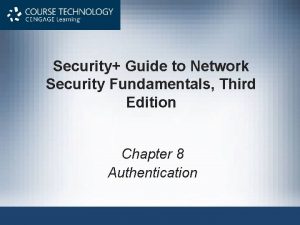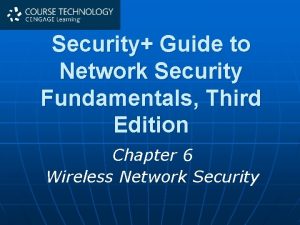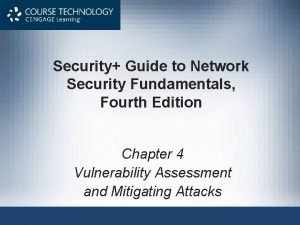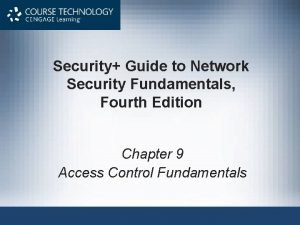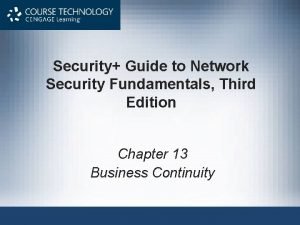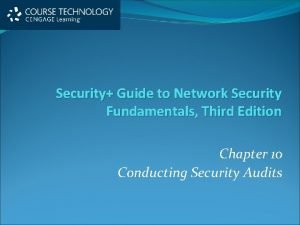Security Guide to Network Security Fundamentals Fifth Edition


















































- Slides: 50

Security+ Guide to Network Security Fundamentals, Fifth Edition Chapter 2 Malware and Social Engineering Attacks

Objectives • • Define malware List the types of malware Identify payloads of malware Describe the types of social engineering psychological attacks • Explain physical social engineering attacks Security+ Guide to Network Security Fundamentals, Fifth Edition 2

Attacks Using Malware • Malware (malicious software) - Software that enters a computer system without the owner’s knowledge or consent • Refers to a wide variety of damaging or annoying software Security+ Guide to Network Security Fundamentals, Fifth Edition 3

Mutating Malware • Attackers can mask the presence of their malware by having it “mutate” or change • Three types of mutating malware are: – Oligomorphic malware - Changes its internal code to one of a set number of predefined mutations whenever executed – Polymorphic malware - Completely changes from its original form whenever it is executed – Metamorphic malware - Can actually rewrite its own code and thus appears different each time it is executed Security+ Guide to Network Security Fundamentals, Fifth Edition 4

Malware Traits: 1 & 2 • Definitions of the different types of malware often confusing and may overlap • One method of classifying various types of malware is using four primary traits that malware possesses: – Circulation - Some malware has primary trait of spreading rapidly to other systems to impact large number users – Infection – Some malware has primary trait of “infect” or embed itself into that system Security+ Guide to Network Security Fundamentals, Fifth Edition 5

Malware Traits: 3 & 4 • Concealment - Some malware has as its primary trait avoiding detection by concealing its presence from scanners • Payload capabilities - When payload capabilities are the primary focus of malware, the focus is on what nefarious action(s) the malware performs Security+ Guide to Network Security Fundamentals, Fifth Edition 6

Virus Types • Computer virus - Malicious computer code that reproduces itself on the same computer • Program virus - Virus that infects an executable program file • Macro virus - One of most common data file viruses written in a script known as a macro (macro is series of instructions that can be grouped together as single command) Security+ Guide to Network Security Fundamentals, Fifth Edition 7

Armored Virus • Different virus infection methods • One common type is appender infection: – Virus appends itself to end of a file – Replaces beginning of file with jump instruction pointing to the virus code • Armored virus - Viruses that go to great lengths to avoid detection • Swiss cheese infection – Encrypts virus code and then divide decryption engine into different pieces and inject these pieces throughout the infected program code Security+ Guide to Network Security Fundamentals, Fifth Edition 8

Appender Infection (Figure 2 -1) Security+ Guide to Network Security Fundamentals, Fifth Edition 9

Swiss Cheese Infection (Figure 2 -2) Security+ Guide to Network Security Fundamentals, Fifth Edition 10

Split Infection • Split infection - Viruses split the malicious code itself into several parts: – Also has one main body of code – All parts are placed at random positions throughout the program code • To make detection even more difficult these parts may contain unnecessary “garbage” code to mask their true purpose Security+ Guide to Network Security Fundamentals, Fifth Edition 11

Split Infection (Figure 2 -3) Security+ Guide to Network Security Fundamentals, Fifth Edition 12

Virus Actions • When infected program is launched it activates its malicious payload • Viruses may display an annoying message but usually much more harmful • Examples of virus actions: – Cause a computer to repeatedly crash – Erase files from or reformat hard drive – Turn off computer’s security settings • Virus also replicates itself by spreading to another file on same computer Security+ Guide to Network Security Fundamentals, Fifth Edition 13

Virus Carriers • Virus cannot automatically spread to another computer • Relies on user action to spread • Viruses are attached to files • Viruses are spread by transferring infected files • Virus must have two “carriers”: – File to which it attaches – Human to transport it to other computers Security+ Guide to Network Security Fundamentals, Fifth Edition 14

Worm • Worm - Malicious program that uses a computer network to replicate • Sometimes called network viruses • Worm designed to enter computer through network and then take advantage of vulnerability in application or operating system on host computer • Once worm exploits vulnerability on one system it immediately searches for another computer on the network that has same vulnerability Security+ Guide to Network Security Fundamentals, Fifth Edition 15

Trojan • Trojan - Program that does something other than advertised • Example: – User downloads “free calendar program” – Program scans system for credit card numbers and passwords – Transmits information to attacker through network Security+ Guide to Network Security Fundamentals, Fifth Edition 16

Difference Between Viruses, Worms, and Trojans (Table 2 -2) Security+ Guide to Network Security Fundamentals, Fifth Edition 17

Rootkit • Rootkit - Software tools used by an attacker to hide actions or presence of other types of malicious software • Will hide or remove traces of log-in records, log entries • May alter or replace operating system files with modified versions specifically designed to ignore malicious activity • Can be difficult to detect a rootkit or clean it from an infected system Security+ Guide to Network Security Fundamentals, Fifth Edition 18

Computer Infected with Rootkit (Figure 2 -4) Security+ Guide to Network Security Fundamentals, Fifth Edition 19

Spyware • Spyware - Software that gathers information without user consent • Spyware is tracking software that is deployed without: – Adequate notice – Consent – Control by the user Security+ Guide to Network Security Fundamentals, Fifth Edition 20

Technologies Used By Spyware (Table 2 -3) Security+ Guide to Network Security Fundamentals, Fifth Edition 21

Keylogger • Keylogger - Program that captures user’s keystrokes • Information later retrieved by attacker • Attacker searches for useful information • Can be either small hardware device or software program • Keyloggers can go beyond capture keystrokes; can also make screen captures and turn on computer’s web camera to record images of user Security+ Guide to Network Security Fundamentals, Fifth Edition 22

Hardware Keylogger (Figure 2 -5) Security+ Guide to Network Security Fundamentals, Fifth Edition 23

Adware • Adware - Program that delivers advertising content in manner unexpected and unwanted by the user • Downsides of adware for users: – – May display objectionable content Frequent pop-up ads cause lost productivity Pop-up ads slow computer or cause crashes Unwanted ads can be a nuisance • Typically displays advertising banners and pop-up ads • Can also perform tracking of online activities Security+ Guide to Network Security Fundamentals, Fifth Edition 24

Ransomware • Ransomware – Program that prevents a user’s device from properly operating until a fee is paid • Ransomware malware is highly profitable • Variation of ransomware displays a fictitious warning that there is a problem with the computer • No matter what the condition of the computer, the ransomware always reports that there is a problem Security+ Guide to Network Security Fundamentals, Fifth Edition 25

Ransomware Message (Figure 2 -6) Security+ Guide to Network Security Fundamentals, Fifth Edition 26

Ransomware Message (Figure 2 -7) Security+ Guide to Network Security Fundamentals, Fifth Edition 27

Logic Bomb • Logic bomb - Computer code that lies dormant until triggered by a specific logical event and then performs malicious activities • Difficult to detect before it is triggered • Logic bombs are often embedded in very large computer programs • Trusted employee can easily insert a few lines of computer code into a long program without anyone detecting it Security+ Guide to Network Security Fundamentals, Fifth Edition 28

Famous Logic Bombs (Table 2 -4) Security+ Guide to Network Security Fundamentals, Fifth Edition 29

Backdoor • Backdoor - Software code that circumvents normal security to give program access • Common practice by developers • Intent is to remove backdoors in final application but often overlooked Security+ Guide to Network Security Fundamentals, Fifth Edition 30

Zombies and Botnets • Zombie - Infected robot (bot) computer • Botnet – Multiple zombie computers gathered into a logical computer network • Bot herder – Attacker who controls bonet • Command control (C&C or C 2) – Instructions from the bot herders regarding which computers to attack and how • Common C&C mechanism used today is Hypertext Transport Protocol (HTTP) Security+ Guide to Network Security Fundamentals, Fifth Edition 31

Uses of Botnets (Table 2 -5) Security+ Guide to Network Security Fundamentals, Fifth Edition 32

Social Engineering Attacks • Social engineering – Means of gathering information from individuals by relying on their weaknesses • Social engineering attacks can involve: – Psychological approaches – Physical procedures Security+ Guide to Network Security Fundamentals, Fifth Edition 33

Social Engineering Psychology • Psychology - The mental and emotional approach in social engineering attack • Social engineering psychological attacks relies on attacker’s clever manipulation of human nature to persuade victim to: – Provide information – Take actions • Several basic “principles” or reasons make psychological social engineering effective Security+ Guide to Network Security Fundamentals, Fifth Edition 34

Social Engineering Effectiveness (Table 2 -6) Security+ Guide to Network Security Fundamentals, Fifth Edition 35

Social Engineering Psychological Approaches • Attacker will ask for only small amounts of information, often from several different victims • Request needs to be believable • Attacker “pushes the envelope” to get information before victim suspects anything • Flattery and flirtation often used • Attacker may smile and ask for help Security+ Guide to Network Security Fundamentals, Fifth Edition 36

Impersonation • Impersonation - Masquerade as a real or fictitious character and then play out the role of that person on a victim • Common roles impersonated: – – – Repairperson IT support Manager Trusted third party Fellow employee Security+ Guide to Network Security Fundamentals, Fifth Edition 37

Phishing • Phishing - Sending email or display web announcement claiming to be from legitimate source • May contain legitimate logos and wording • Tries to trick user into giving private information – – Passwords Credit card numbers Social Security numbers Bank account numbers Security+ Guide to Network Security Fundamentals, Fifth Edition 38

Phishing Email Message (Figure 2 -8) Security+ Guide to Network Security Fundamentals, Fifth Edition 39

Common Phishing Features • Common phishing features – Deceptive web links - Use variations of a legitimate address (www. ebay_secure. com, www. e—bay. com, www. e-baynet. com) – Logos - Include logo of vendor to make request look genuine – Urgent request - Include instructions requiring immediate action or else something serious will occur (user’s account will be unavailable or a large amount of money will be deducted from their account) Security+ Guide to Network Security Fundamentals, Fifth Edition 40

Phishing Variations • Variations of phishing: – Pharming - Automatically redirects user to fraudulent web site – Spear phishing - Email messages target specific users – Whaling - Going after the “big fish” by targeting wealthy individuals – Vishing (voice phishing) - Attacker calls victim with recorded message with callback number, but number is actually to attacker Security+ Guide to Network Security Fundamentals, Fifth Edition 41

Spam • • • Spam - Unsolicited email One of primary vehicles for distribution of malware Sending spam is lucrative business Spim - Targets instant messaging users Image spam: – Uses graphical images of text – Circumvents text-based filters – Often contains nonsense text Security+ Guide to Network Security Fundamentals, Fifth Edition 42

Image Spam (Figure 2 -9) Security+ Guide to Network Security Fundamentals, Fifth Edition 43

Hoaxes • Hoaxes - False warning or claim • May be first step in an attack • Hoax purports that “deadly virus” circulating through the Internet and that the recipient should: – Erase specific files – Change security configurations – Forward message to other users • However, changing configurations allow an attacker to compromise the system Security+ Guide to Network Security Fundamentals, Fifth Edition 44

Typo Squatting • Typo squatting (URL hijacking) – Attacker registers fake look-alike site to which user is automatically directed when makes a typing error when entering URL address in a web browser (goggle. com or google. net instead of google. com) • Site may contain: – Visitor survey that promises a chance to win prizes (but the attacker actually captures the entered email addresses to sell to spammers) – Ads (for which the attacker receives money for traffic generated to the site) Security+ Guide to Network Security Fundamentals, Fifth Edition 45

Watering Hole Attack • Similar types of animals congregate around a pool of water for refreshment • Watering hole attack - Directed toward smaller group of specific individuals, such as the major executives working for a manufacturing company • These executives all tend to visit a common website, so attacker focuses on compromising that site Security+ Guide to Network Security Fundamentals, Fifth Edition 46

Social Engineering Physical Procedures • Just as some social engineering attacks rely on psychological manipulation, other attacks rely on physical acts • These attacks take advantage of user actions that can result in compromised security Security+ Guide to Network Security Fundamentals, Fifth Edition 47

Dumpster Diving • Dumpster diving - Digging through trash to find useful information Security+ Guide to Network Security Fundamentals, Fifth Edition 48

Tailgating and Shoulder Surfing • Tailgating – Following an authorized person entering through a door • Methods of tailgating: – Tailgater calls “please hold the door” – Waits outside door and enters when authorized employee leaves – Employee conspires with unauthorized person to walk together through open door • Shoulder surfing - Casually observing user entering keypad code Security+ Guide to Network Security Fundamentals, Fifth Edition 49

Security+ Guide to Network Security Fundamentals, Fifth Edition Chapter 2 Malware and Social Engineering Attacks
 Security guide to network security fundamentals
Security guide to network security fundamentals Security guide to network security fundamentals
Security guide to network security fundamentals Security guide to network security fundamentals
Security guide to network security fundamentals Fundamentals of corporate finance fifth edition
Fundamentals of corporate finance fifth edition Computer security fundamentals 4th edition
Computer security fundamentals 4th edition Principles of marketing fifth european edition
Principles of marketing fifth european edition Appraisals in lazarus theory of emotion
Appraisals in lazarus theory of emotion Democritus atomic model diagram
Democritus atomic model diagram Molecular biology of the cell fifth edition
Molecular biology of the cell fifth edition Molecular biology
Molecular biology Human anatomy fifth edition
Human anatomy fifth edition Human anatomy fifth edition
Human anatomy fifth edition William stallings network security essentials 5th edition
William stallings network security essentials 5th edition Modulo table
Modulo table Cryptography and network security 6th edition pdf
Cryptography and network security 6th edition pdf Cryptography and network security 4th edition
Cryptography and network security 4th edition Network security essentials 5th edition
Network security essentials 5th edition Cryptography and network security pearson
Cryptography and network security pearson Fundamentals of information systems 9th edition
Fundamentals of information systems 9th edition Fundamentals of information systems 9th edition
Fundamentals of information systems 9th edition Fluid mechanics fundamentals and applications 3rd edition
Fluid mechanics fundamentals and applications 3rd edition Digital electronics by floyd
Digital electronics by floyd Machining fundamentals 10th edition
Machining fundamentals 10th edition Fundamentals of organizational communication
Fundamentals of organizational communication Fundamentals of organizational communication 9th edition
Fundamentals of organizational communication 9th edition Fundamentals of corporate finance, third canadian edition
Fundamentals of corporate finance, third canadian edition Floyd digital fundamentals ppt
Floyd digital fundamentals ppt Digital fundamentals floyd ppt
Digital fundamentals floyd ppt Electronics fundamentals a systems approach
Electronics fundamentals a systems approach Management fundamentals 8th edition
Management fundamentals 8th edition Fundamentals of information systems
Fundamentals of information systems Fundamentals of corporate finance canadian edition
Fundamentals of corporate finance canadian edition Corporate finance 6th edition
Corporate finance 6th edition Lysanx
Lysanx Fundamentals of information systems 9th edition
Fundamentals of information systems 9th edition Thermal conduction resistance
Thermal conduction resistance The fundamentals of political science research 2nd edition
The fundamentals of political science research 2nd edition Osi security architecture in hindi
Osi security architecture in hindi Wireless security in cryptography and network security
Wireless security in cryptography and network security Electronic mail security in network security
Electronic mail security in network security Mis chapter 6
Mis chapter 6 Using mis (10th edition) 10th edition
Using mis (10th edition) 10th edition Private securty
Private securty Intermediary devices
Intermediary devices Campus network design fundamentals
Campus network design fundamentals Florida real estate broker's guide
Florida real estate broker's guide Florida real estate broker's guide 6th edition
Florida real estate broker's guide 6th edition A pocket guide to public speaking 6th edition free
A pocket guide to public speaking 6th edition free Guide to wireless communications 4th edition
Guide to wireless communications 4th edition Marking bad clusters data hiding technique
Marking bad clusters data hiding technique Prehospital emergency care 11th edition
Prehospital emergency care 11th edition












































